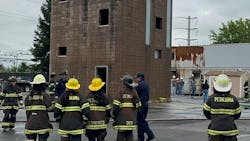Key Takeaways:
- Leaders at all ranks must model change-positive behavior and work together to maintain consistency and alignment in driving initiatives forward.
- Change is more readily accepted when firefighters trust their leaders’ intentions, there is transparency and consistent communication within the organization.
- Adequate training and hands-on practice reduces anxiety and builds confidence when adopting new procedures or implementing technologies.
Change resistance within the fire service is a critical issue in our effectiveness, evolution and duty to the community. It poses significant challenges to implementing new methods, technologies and organizational improvements, thus hindering our ability to adapt to evolving demands and to better serve the community. Understanding the root causes of this resistance and developing strategies to manage it are crucial to creating and sustaining a positive culture.
Understanding change resistance
Reluctance to accept or support organizational changes can take various forms, from passive skepticism to outright opposition and conflict. Two of the key factors that contribute to this are deep-rooted traditions and culture.
Fire organizations often have a strong sense of identity and history. These traditions create a cultural barrier to change, because firefighters might perceive new methods or technologies as threats to their established way of doing things. Understanding this is crucial for leaders, because it helps them to better comprehend their personnel’s mindset and address their concerns.
Additionally, fear of the unknown can introduce uncertainty, which can lead to anxiety among personnel. Firefighters might worry about adapting to new roles, technologies or procedures, which can further increase resistance.
Effective leadership and clear communication are essential to navigate these barriers and alleviate fears associated with the unknown.
Trust is imperative
Building and maintaining trust in leadership is one of the most effective strategies for managing change resistance. When firefighters have confidence in their leaders’ intentions and competence, they are more likely to embrace the changes that are proposed by those leaders. This trust isn’t built overnight, but it’s crucial to fostering a positive culture and facilitating accepting changes.
To promote this trust, leaders must communicate transparently, involve team members in decision-making and demonstrate a commitment to those members’ well-being. Leaders can achieve this by being visible and approachable and by providing continuous support and training opportunities.
Fostering a culture of continuous improvement
Encouraging firefighters to view change as a positive and ongoing process rather than a one-time event can reduce resistance significantly. This promotes innovation and adaptation as integral parts of the fire service’s mission to protect and serve the community. Leaders can do this by celebrating small wins, recognizing efforts to adapt, and continually highlighting the benefits of new practices and technologies.
Implementing a continuous improvement culture involves creating an environment where feedback is regularly sought and valued. This includes conducting regular debriefings after incidents to identify areas for improvement and encouraging firefighters to suggest innovations. By embracing this practice, departments can create a mindset that embraces change and that sees it as an opportunity for growth and enhancement of skills and services.
Engaging and empowering personnel
Engaging firefighters in the change process is crucial. Personnel who feel involved and valued are more likely to support and participate in change initiatives. This can be achieved by soliciting feedback, involving firefighters in decision-making and creating forums for open discussion about proposed changes.
Empowering firefighters to take ownership of change initiatives also can be effective. When individuals feel as though they have a stake in the outcome, they are more motivated to contribute positively. Creating subgroups or ad hoc committees that comprise a diverse selection of members empowers members to feel as though they belong and allows them to embrace change.
Empowerment also involves providing firefighters with the authority to make decisions that are within their areas of expertise. This decentralized approach can increase their commitment to change initiatives, because they feel more responsible for the success of these efforts. Leaders should encourage firefighters to lead on specific projects or improvements, to foster a sense of pride and ownership in the implemented changes.
Providing adequate training and resources
Resistance often stems from a lack of confidence in adapting to new methods or technologies. Providing adequate training and resources can mitigate these fears.
Leaders should ensure that all personnel receive comprehensive training on new procedures and have access to the necessary tools and resources to implement changes effectively.
Continual education and professional development opportunities also can help firefighters to feel more prepared and less anxious about changes.
In addition to formal training sessions, creating opportunities for hands-on practice and simulations can be beneficial. These practical experiences allow firefighters to familiarize themselves with new equipment and procedures in a controlled environment, which reduces anxiety and builds competence.
Ongoing support and refresher courses also should be part of the training strategy, to reinforce learning and address emerging challenges.
Effective communication
Effective communication is critical in managing change resistance. Leaders must clearly articulate the reasons for change, the benefits that it will bring and the specific steps that will be taken to implement it.
Transparency throughout the process helps to build trust and reduce uncertainty. Regular updates, open forums and opportunities for feedback can help to maintain open lines of communication.
It also is essential to listen to the concerns and suggestions of firefighters and to address them promptly.
Leaders should use multiple communication channels, including face-to-face meetings, to reach all members. Tailoring the message to different audiences that are within the department also can enhance understanding and buy-in. For example, explaining the operational benefits to front-line firefighters and the strategic advantages to higher-level officers can ensure that the message resonates with everyone.
Building a supportive leadership team
Leaders at all levels of the organization must be aligned in their support for change initiatives. This unity of purpose helps to reinforce the message that change is necessary and beneficial.
Leaders should model the behaviors and attitudes that they expect from their crews and provide consistent support and encouragement throughout the change process.
Creating a cohesive leadership team involves regular meetings to discuss progress, challenges and strategies that are related to change initiatives. Leaders should share insights and collaborate on solutions, to present a united front to the rest of the organization. This collaborative approach also can help to identify and address resistance within the leadership team, to ensure that all leaders are fully committed to the change process. This is critical in the chain of organizational success; if one link is broken, the rest of the chain is deemed a failure.
Addressing the emotional effects of change
Change can affect firefighters’ emotions significantly. Acknowledging and addressing these emotions is a critical aspect of managing resistance.
Leaders should be empathetic and understanding and provide support and reassurance as needed. Creating a supportive environment in which firefighters feel comfortable expressing their concerns and fears can help to alleviate anxiety and build resilience.
Emotional support can be provided through various means, such as counseling services, peer-support programs and stress-management workshops. Leaders also should recognize and validate the feelings of their personnel, to show that they understand the emotional toll that change can incur. This empathetic approach can foster a sense of community and solidarity, to help firefighters to navigate the emotional challenges of change.
Highlighting success stories
Sharing success stories from other departments that successfully implemented similar changes can be a powerful motivator. These examples demonstrate the tangible benefits of change (e.g., improvements in efficiency, safety and service), provide a roadmap for successful implementation, and help to build momentum and to reduce skepticism. Detailed and relatable stories resonate with firefighters’ experiences and challenges, to foster a sense of shared purpose and accomplishment.
Equally important is celebrating and highlighting the success stories within one’s own organization during the progression along the roadmap for success and while meeting critical benchmarks. Showcasing achievements motivates members and validates efforts and strategies.
By celebrating these successes, leaders can inspire confidence and optimism about the potential benefits of change. This recognition reinforces commitment to continuous improvement and encourages everyone to stay engaged and motivated on the journey toward excellence.
Turn resistance into resilience
Overcoming resistance to change in the fire service requires a multifaceted approach that addresses both the practical and emotional aspects of change. By fostering a culture of continuous improvement, engaging and empowering personnel, providing adequate training and resources, communicating effectively, building a supportive leadership team, addressing the emotional effects of change and highlighting success stories, leaders can navigate the complexities of change and ensure a smoother transition. The commitment to embracing change enhances the effectiveness and efficiency of departments, to ensure that they are better equipped to meet the evolving needs of the communities that they serve.
Looking forward, leaders must continue to innovate and adapt to new challenges and opportunities. Embracing advancements in technology, enhancing community engagement, promoting diversity and inclusion, strengthening mental health support, expanding training programs, emphasizing leadership development, leveraging community partnerships and utilizing social media are all critical strategies for ensuring the future success of departments.
By implementing these strategies, leaders can turn resistance into resilience, to pave the way for a more adaptive and forward-thinking fire service. The capability to embrace and manage change effectively is crucial for departments’ continued growth and success, ultimately enhancing their capability to protect and serve the public. The ongoing commitment to improvement and innovation ensures that departments remain capable and ready to meet future challenges, safeguarding the communities that they are dedicated to protect.

Chad Costa
Chad Costa is the assistant chief for the Petaluma, CA, Fire Department. With more than 26 years of fire service experience, he has worked in various organizations, including CAL FIRE, rural and semi-rural districts, and a city. As a battalion chief, Costa was the technology and communications battalion chief. He is now a rostered operations branch director for CalFire Team 1 and an alternate operations section chief trainee on California Interagency Team 5. Costa is an accredited Chief Fire Officer through the Center for Public Safety Excellence and has a bachelor’s degree in emergency services management, a master’s degree in fire service leadership, and a certificate in homeland security. Costa has also completed the Executive Chief Officer Program at the National Fire Academy. Costa is a member of the Firehouse Editorial Advisory Board.






